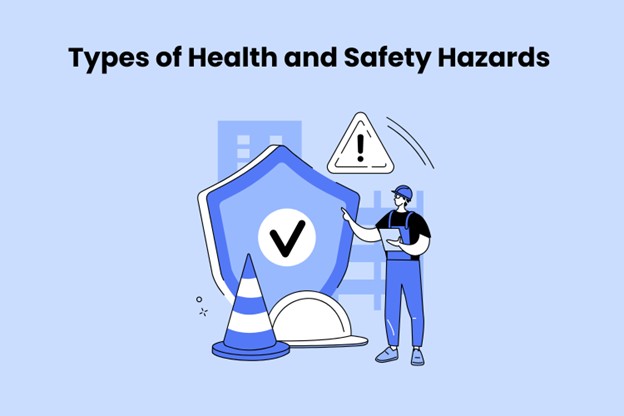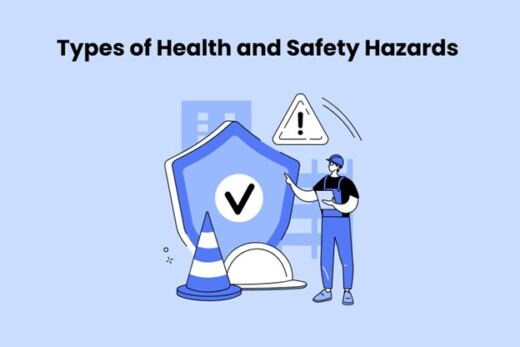Health and safety hazards types guide, Property H&S, IOSH courses, Building construction training advice, Risk management
Types of Health and Safety Hazards
8 March 2024
In a dynamic and modern work environment, ensuring the health and safety of employees is important. Employers and employees alike must be vigilant in identifying and mitigating various types of health and safety hazards to maintain a secure workplace.
nderstanding the diverse range of hazards is essential for effective risk management and compliance with safety regulations. This blog delves into the different types of Health and Safety Hazards, shedding light on the importance of awareness and proper training, such as IOSH Courses, in addressing these challenges head-on.
Table of Contents
- Physical Hazards
- Chemical Hazards
- Biological Hazards
- Psychosocial Hazards
- Electrical Hazards
- Fire Hazards
- Conclusion
Physical Hazards
Physical hazards encompass a broad spectrum of dangers present in the workplace environment. These hazards include factors such as noise, vibration, extreme temperatures, radiation, and ergonomic stressors.
Exposure to excessive noise levels, for instance, can lead to hearing loss over time, while repetitive motions without ergonomic support may result in musculoskeletal disorders. Employers must implement measures to control these hazards, such as providing ear protection and ergonomic workstations, to safeguard employees’ physical well-being.
Chemical Hazards
Chemical hazards pose significant risks to workers across various industries, including manufacturing, healthcare, and agriculture. These hazards stem from exposure to harmful substances such as gases, liquids, dust, and fumes, which can cause respiratory problems, skin irritations, and even long-term health issues like cancer.
Proper handling, storage, and disposal of hazardous chemicals are imperative to prevent accidents and minimize health risks. Comprehensive training through IOSH courses can equip employees with the knowledge and skills needed to handle chemicals safely and effectively.
Biological Hazards
Biological hazards arise from exposure to living organisms or their byproducts, including viruses, bacteria, fungi, and parasites. Workers in healthcare, laboratories, and agricultural settings are particularly vulnerable to these hazards.
Inadequate infection control measures can lead to the spread of diseases such as COVID-19, hepatitis, and tuberculosis. Employers must prioritize hygiene practices, provide personal protective equipment (PPE), and implement appropriate protocols to mitigate the risk of biological hazards in the workplace.
Psychosocial Hazards
Psychosocial hazards encompass factors that affect employees’ mental and emotional well-being in the workplace. These hazards include stress, workplace violence, bullying, and harassment.
Prolonged exposure to high levels of stress can lead to burnout, anxiety, depression, and other mental health issues. Creating a supportive work environment, promoting work-life balance, and offering access to counseling services can help alleviate psychosocial hazards and foster a positive workplace culture.
Electrical Hazards
Electrical hazards pose a significant risk to workers in industries where electricity is prevalent, such as construction, manufacturing, and utilities. These hazards include electric shock, arc flashes, and fires, which can result from faulty wiring, exposed electrical parts, or improper use of equipment.
Employers must ensure that electrical systems are properly installed, maintained, and inspected regularly to prevent accidents. Additionally, employees should receive training on electrical safety practices and procedures through IOSH courses to mitigate the risk of electrical hazards.
Fire Hazards
Fire hazards are a constant threat in workplaces, regardless of the industry. Factors such as combustible materials, electrical faults, and improper storage can contribute to the risk of fires. Employers must implement fire safety measures, including the installation of fire alarms, extinguishers, and emergency evacuation plans.
Regular fire drills and training sessions can help prepare employees to respond effectively in a fire emergency, reducing the potential for injuries and property damage.
Health and safety hazards types Conclusion
Health and safety hazards come in various forms, each presenting unique risks to workers in different industries. Identifying and addressing these hazards requires a proactive approach, with employers prioritizing risk assessment, mitigation strategies, and comprehensive training programs such as IOSH courses.
By fostering a culture of safety and investing in preventive measures, organisations can create safer and healthier workplaces for their employees, ultimately enhancing productivity and well-being. Stay informed, prepared, and prioritize safety.
Comments on this guide to Health and safety hazards types article are welcome.
Building Health and Safety Hazards
Urban spaces need to be designed for safety
Navigating safety standards and compliance in confined spaces
Gas pipelines in construction installation, inspection, safety
Architecture
Rowanbank Gardens Edinburgh Housing
Comments / photos for the Health and safety hazards types page welcome.





